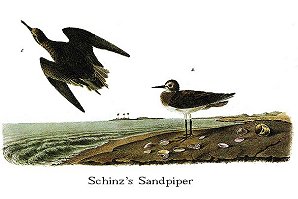
| Family XXXVI. SCOLOPACINE. SNIPES. GENUS I. TRINGA, Linn. SANDPIPER. |
Next >> |

Family |
SCHINZ'S SANDPIPER. [White-rumped Sandpiper.] |
| Genus | TRINGA SCHINZII, Brehm. [Calidris fuscicollis.] |
Although I have met with this species at different times in Kentucky, and along our extensive shores, from the Floridas to Maine, as well as on the coast
of Labrador, I never found it breeding. Indeed, I have not met with it in the
United States excepting in the latter part of autumn and in winter. Those
procured in Labrador were shot in the beginning of August, and were all young
birds, apparently about to take their departure. My drawing of the two
individuals represented in the plate was made at St. Augustine in East Florida,
where I procured them on the 2nd of December, 1831. I have always found these
birds gentle and less shy than any other species of the genus. They fly at a
considerable height with rapidity, deviating alternately to either side, and
plunge toward the ground in a manner somewhat resembling that of the Solitary
Sandpiper. When accidentally surprised, they start with a repeated weet, less
sonorous than that of the bird just mentioned. They search for food along the
margins of pools, creeks and rivers, or by the edges of sand-bars, and mix with
other species.
TRINGA SCHINZII, Bonap. Syn., p. 249.
TRINGA SCHINZII, Schinz's Sandpiper, Swains. and Rich. F. Bor. Amer. vol. ii. p. 384.
SCHINZ'S SANDPIPER, Nutt. Man., vol. ii. p. 109.
SCHINZ's SANDPIPER, Tringa Schinzii, Aud. Orn. Biog., vol. iii. p. 529.
Male, 7 1/2, 14 3/4
From Labrador to St. Augustine in Florida, and Kentucky, during autumn.
Missouri. Saskatchewan Plains. Not very rare. Migratory. Breeds in high
northern latitudes.
Adult Male, in winter.
Bill about the length of the head, slender, sub-cylindrical, straight,
compressed at the base, the point slightly enlarged and rather obtuse. Upper
mandible with the dorsal line straight, excepting at the tip, the ridge narrow
and convex, broader and flattened towards the end, the sides sloping, the edges
rather obtuse. Nasal groove extending to near the tip; nostrils basal, linear,
pervious. Lower mandible with the angle long and extremely narrow, the dorsal
line straight, the sides sloping outwards, the tip a little broader than that of
the upper.
Head rather small, oblong, compressed. Neck of moderate length. Body
rather slender. Feet rather long, slender; tibia bare a third part of its
length; tarsus compressed behind, covered anteriorly and posteriorly with
numerous scutella, which scarcely leave any intermediate space; hind toe
extremely small; the rest of moderate length, slender, the fourth slightly
longer than the second, the third longest; all free, there being only a very
slight rudimentary web between the third and fourth, flat beneath, slightly
marginate with rather pointed scales. Claws small, slightly arched, compressed,
rather acute, that of the third toe much larger, with the inner edge dilated.
Plumage very soft, blended on the lower parts, the feathers distinct above.
Wings very long, pointed; primaries tapering, obtuse, the first longest, the
second almost equal, the rest rapidly graduated; outer secondaries incurved,
narrow, obliquely sinuate at the end of the outer web, the inner rounded and
extending beyond the outer; inner secondaries very narrow, tapering to a point,
reaching, when the wing is closed, to about half an inch from its tip. Tail of
moderate length, nearly even, but with the two middle feathers exceeding the
rest, the number of feathers twelve.
Bill and feet dusky. Iris brown. The general colour of the upper parts is
brownish-black, each feather edged with yellowish-grey, the scapulars with light
red. Wing-coverts greyish-brown, the shaft black; primary and secondary coverts
tipped with white; quills brownish-grey, darker towards the tips, the inner
primaries and outer secondaries more or less edged and tipped with white; the
tail-coverts white, with a dusky spot, excepting the two central, which are
blackish, with a few greyish-white markings. Tailfeathers light grey, the two
middle brownish-black towards the end. Sides of the head, fore neck, anterior
part of breast and sides greyish-white, with small lanceolate central
brownish-black spots; the rest of the lower parts white.
Length to end of tail 7 1/12 inches, to end of wings 7 7/12, to end of
claws 7 9/12; extent of wings 14 3/4, bill along the back (10 1/2)/12, along the
edge of lower mandible 11/12; wing from flexure 4 (10 1/2)/12; tail 2 2/12;
tarsus 11/12; middle toe (9 1/2)/12, its claw 2/12.
Adult Female, in winter.
The female is similar to the male, but a little smaller.
In some individuals, about six of the middle tail-coverts are black, the
lateral barred with white and dusky.
| Next >> |